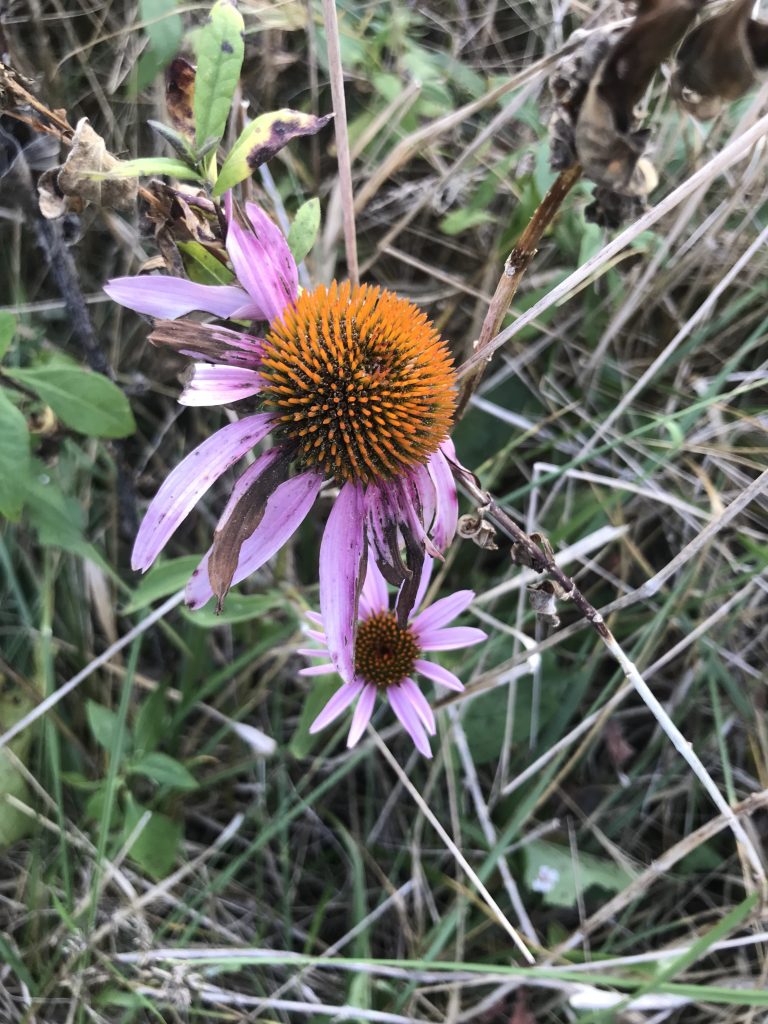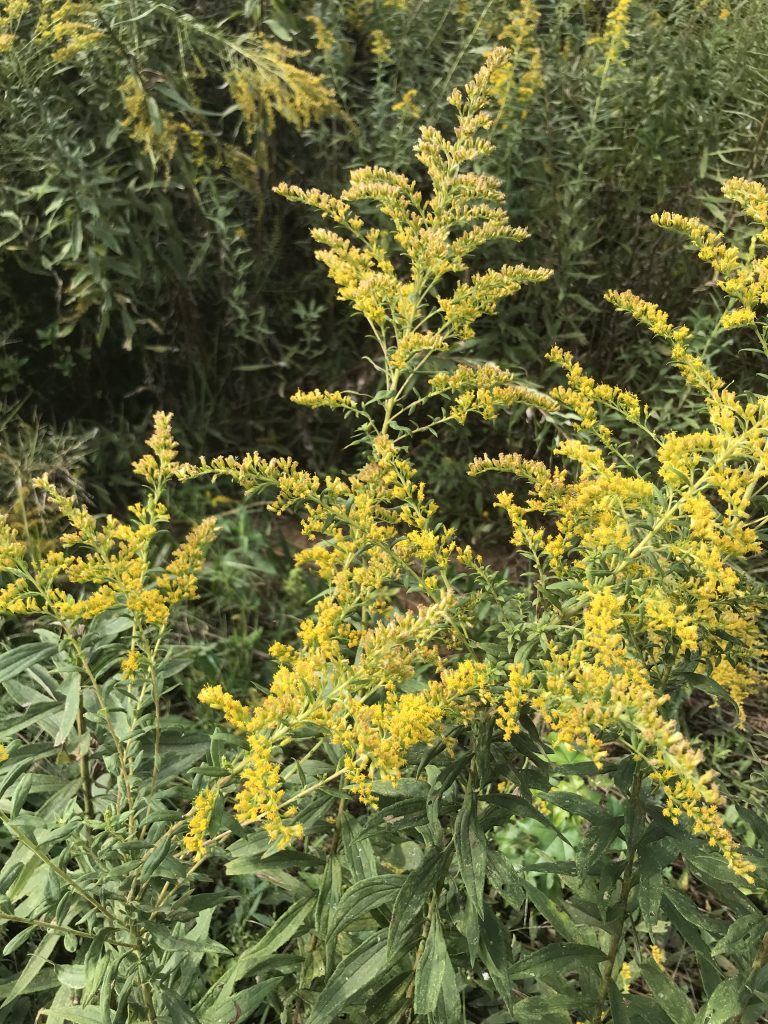
These are medicinal herbs that can be found within a 25-mile radius of Guilford College, located in Greensboro, NC! I have included fungi and berries into this section of the site to have a variety of medicinal plants/other organisms to reap benefits from.
Burdock: (Arctium) This herb is a member of the Asteraceae family. Its common names include Burdock, Beggar’s Buttons, Clotbur, and Wild burdock. Burdock’s chemical compounds include “chlorogenic acid, taraxosterol, arctigen, mucilage, resin; arctigenin, arctic acid; volatile oils & acids; non-hydroxy acids; and sucrose” (Light). Burdock can be identified by its wavy heart-shaped leaves, burs that stick to your clothing or animal fur, purple flowers that grow at the end of the prickly balls off of the plant.
Medicinal Benefits: encourages healthy digestion and appetite, helps with clear skin/complexion, promotes normal liver function. (Gaia Herbs)

Chickweed: The herb is a member of the Caryophyllaceae family. Its common names are The chemical compounds of Chickweed are “borneol, menthol, linalool, 1,8-cineole, and other terpenes such as epoxy-dehydro-caryophyllene, monoterpene alcohol-ester, and caryophyllene” (Chickweed). This herb can be identified by its small tear-drop shaped leaves, it grows no more than 2 to 4 inches above the ground. As well as its small white flowers, and that it grows in a string/vine-like fashion, all together.
Medicinal Benefits: Applied on to the skin to treat burns, rashes, irritated skin, wounds, and dry skin. Historically Chickweed was used to “asthma, constipation, menstrual pain, and respiratory illnesses” (Wong).

Dandelion: (Taraxacum) The herb is a member of the Asteraceae family. Its common names include bitterwort, blow-ball, cankerwort, clockflower, common dandelion. The chemical compounds of Chickweed are “sesquiterpe lactone, inulin, chicoric acid, taraxasterol, lupeol, amyrin, cycloartenol, cynaroside, and aesculin” (Dandelion). This herb can be identified by its bright yellow flowers that grow from the center of the plant, its jagged leaf shape, and the white flower that also grows from the plant.
Medicinal Benefits: Helps with urinary tract support, digestive support, Dandelion is rich in vitamins A, B complex, and C as well as iron, potassium, and zinc. (Gaia Herbs)

Echinacea: (Echinacea purpurea) The herb is a member of the Asteraceae family. Its common names include Narrow-leaf coneflower, purple coneflower, smooth purple coneflower, and Echinacea. The chemical compounds of Chickweed are “chicoric acid, echinacoside, caftaric acid, and cynarine” (Echinacea). This herb can be identified by its height of three feet, it’s daisy-like purple/pink flowers, leaves that are narrow, toothed, and rough to the touch.
Medicinal Benefits: Immune support, has large amounts of “Alkylamides and support a healthy inflammatory repose in the sinuses and are best used at onset” (Gaia Herbs).

Elderberry: (Sambucus) The herb is a member of the Moschatel family. Its common names are elder, elderberry, black elderberry, and European elderberry. The chemical compounds of Chickweed are”Sambubiose and Sambunigrin” (American). This herb can be identified by its leaves which are long and have sawtooth-shaped edges. there are 5 to 7 leaves no each stem. It can also be identified by the small dark purple berries that grow in clusters at the end of each stem.
Medicinal Benefits: Good source of vitamin C, fiber, and antioxidants. Acts as a digestive aid.

Goldenrod: (Solidago spp.) is a member of the Asteraceae family. Its common names include woundwort and Aaron’s rod. Goldenrod’s chemical compounds include flavonoids, phenolic acids, glucosides, polysaccharides, diterpenes, triterpenoid, saponosides, saponins, and tannins (Rolson). This herb can be identified by its bright yellow plume-like flowers and its leaves that are toothed along the edges and are hairy to the touch.
Medicinal Benefits: “Goldenrod is an important dermatological aid for sores, infections, toothache, burns, and wounds” (Goldenrod). It also can be used to treat urinary issues, respiratory and digestive problems too.

Lions Mane Mushroom: The herb is a member of the Hericiaceae family. Its common names are lion’s mane mushroom, monkey head mushroom, bearded tooth mushroom, and pom pom mushroom. The chemical compounds of Chickweed are “antibiotic, anticarcinogenic, antidiabetic, antifatigue, antihypertensive, antihyperlipodemic, antisenescence, cardioprotective, hepatoprotective, nephroprotective, and neuroprotective” (Friedman). This herb can be identified by its white and yellowish color. This mushroom will turn an orange color when it is past its prime. It has a puff ball-like shape.
Medicinal Benefits: Brain and Cognitive support and stress support. “this mushroom [Lions Mane] contain polysaccharides, specifically a type called beta-glucans, which have been studied to support immune health and overall wellness” (Gaia Herbs).
Turkey Tail Mushroom: (Trametes versicolor)The herb is a member of the Polyporaceae family. Its common names are its scientific name, Trametes versicolor, coriolus vesicolor, Polyporus versocolor, and turkey tail. The chemical compounds of Chickweed are “4-isobutoxyphenyl palmitate, N-D-2′-hydroxyheptanoic-1-O-β-D-glucopyranosyl-9-methyl-4,8-sphinga-dienine(cereb roside) , 3β-linoleyloxyergosta-7,22-diene , 3β-linoleyloxyergosta-7-ene , and betulinic acid” (Habibi). This herb can be identified by its small pores along the underside of the mushroom, contrasting colors in its stripes, and that its surface is slightly fuzzy.
Medicinal Benefits: Immune support and Liver/Cleanse Support. This mushroom also contains ploysaccharides that help to “support immune health and overall well being” (Gaia Herbs).

